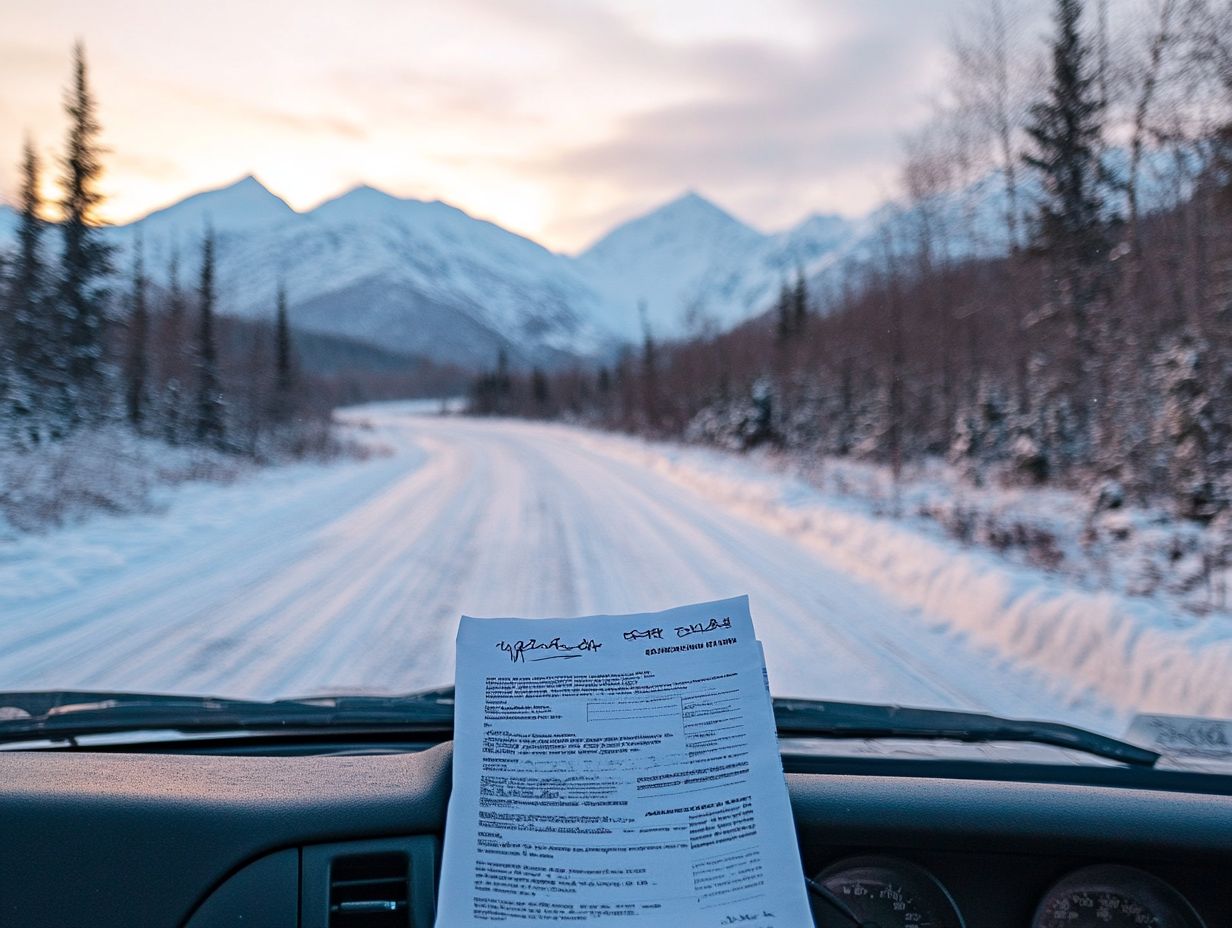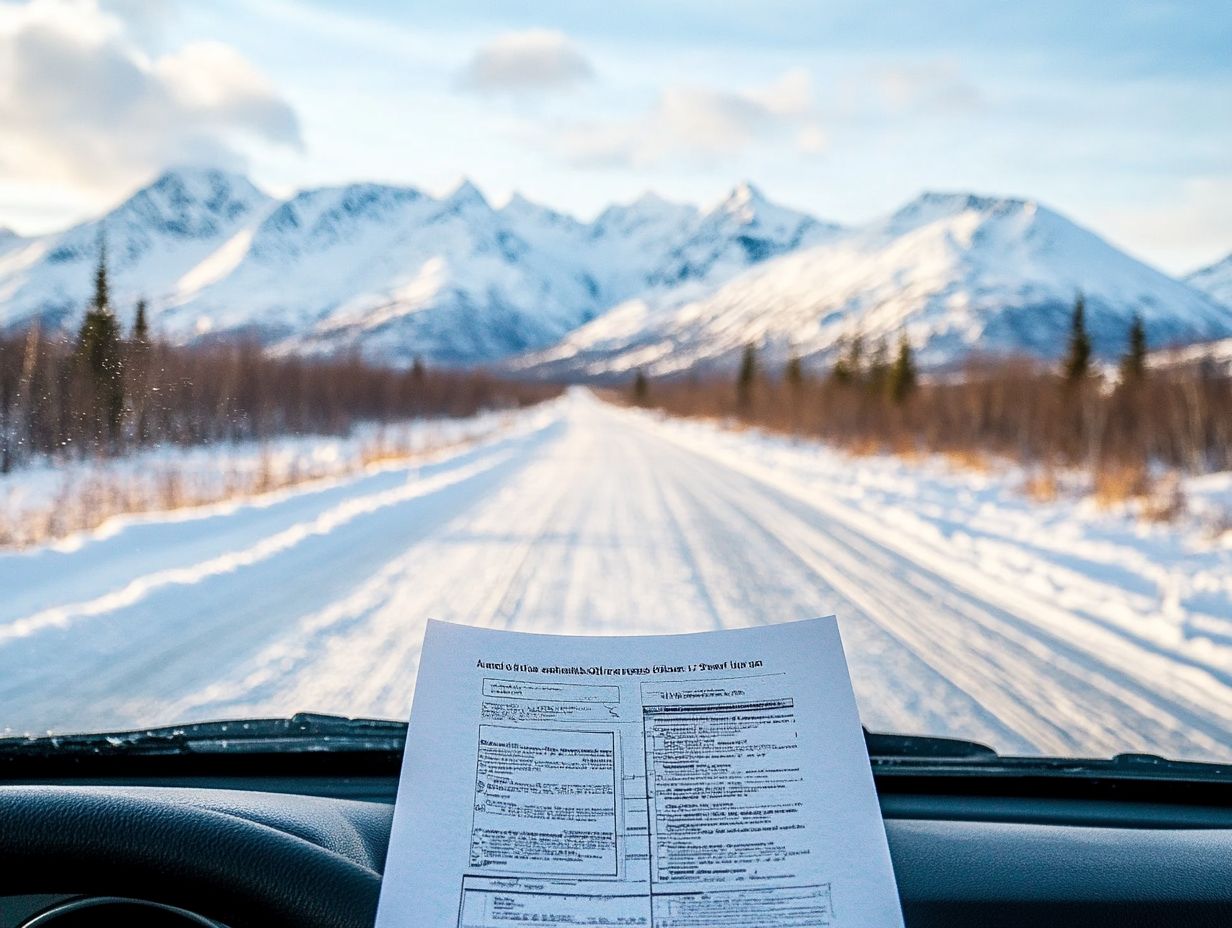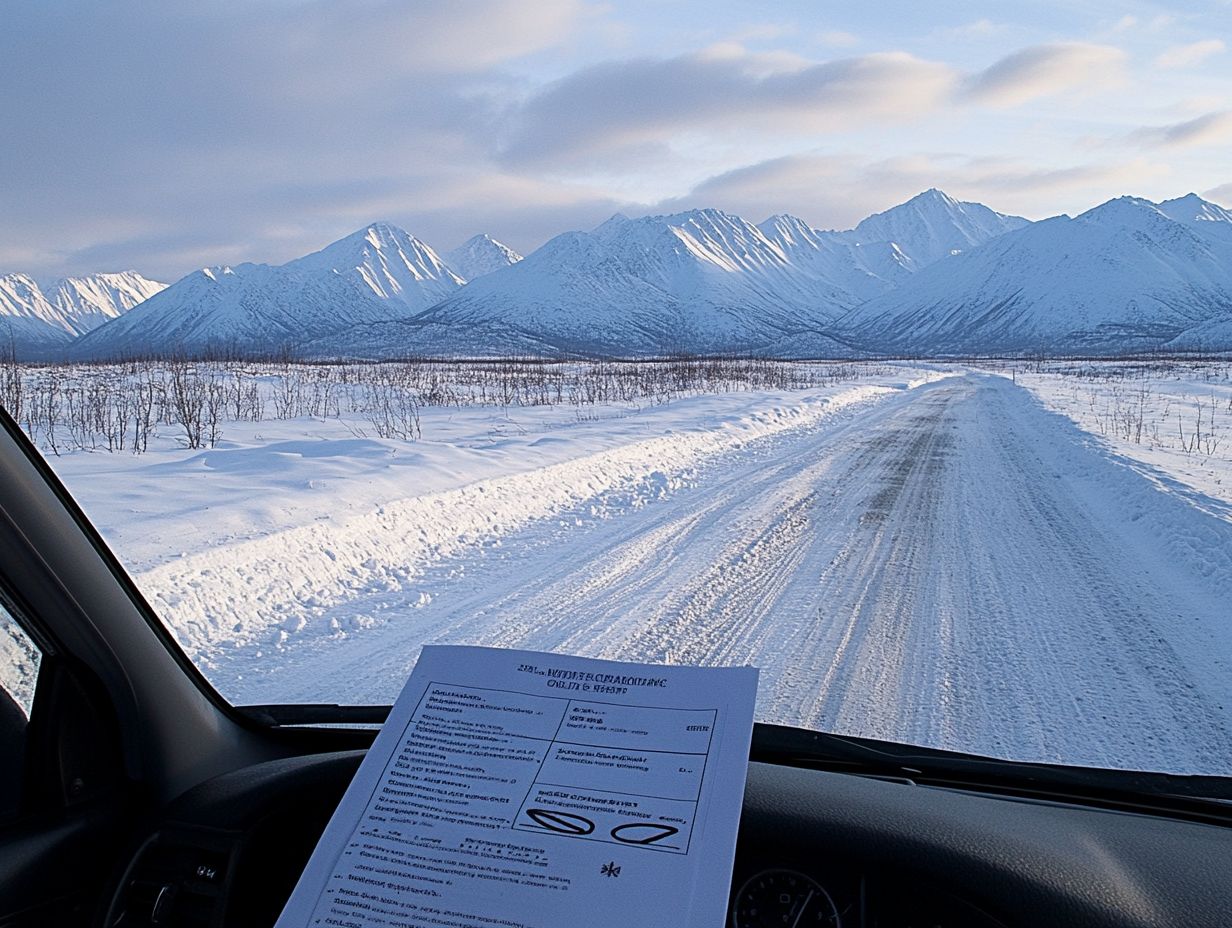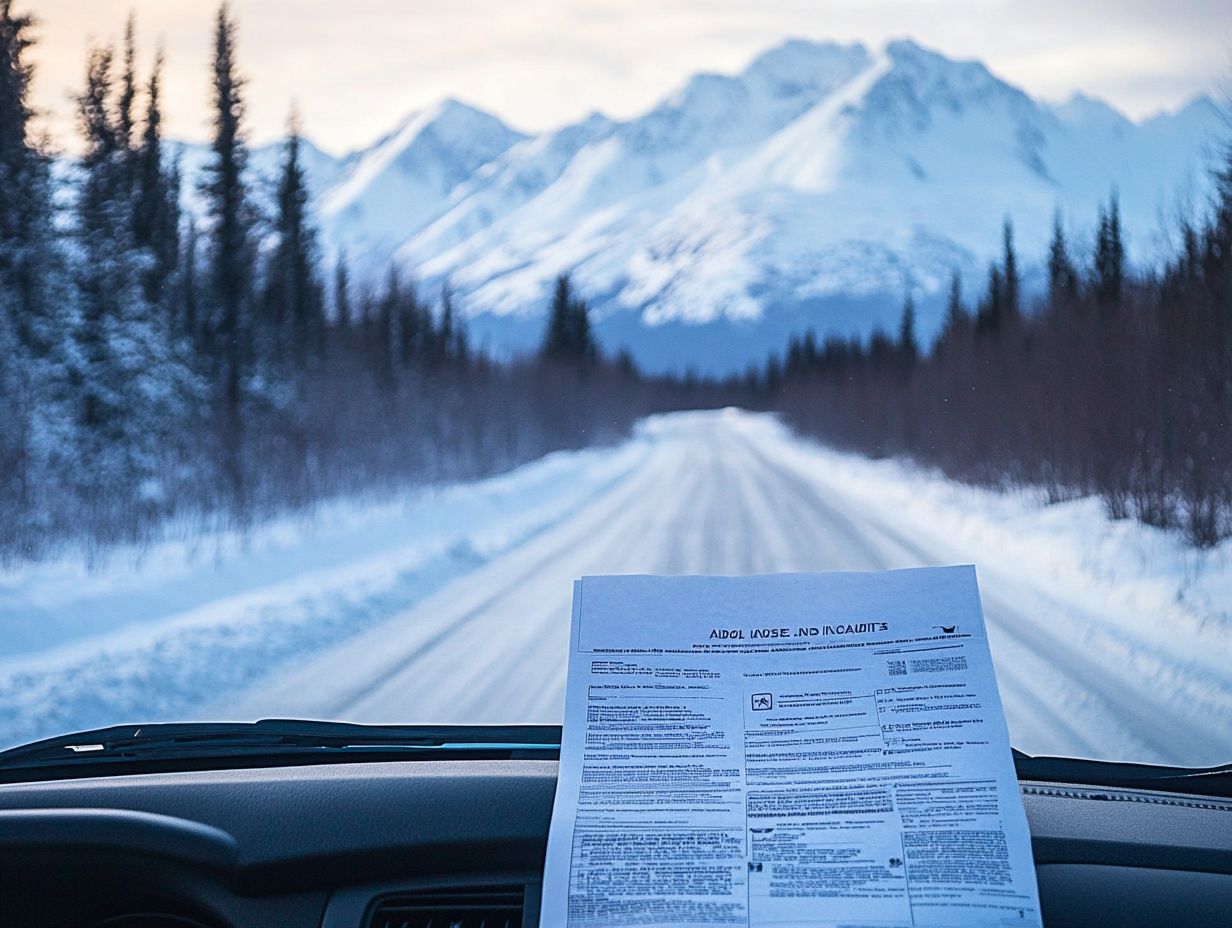Alaska Auto Insurance Regulations Explained
Navigating the world of auto insurance in Alaska may feel overwhelming! However, grasping the regulations is crucial for securing the right coverage.
This guide simplifies the essential requirements, detailing minimum coverage mandates and the various types of insurance available, such as bodily injury liability and personal injury protection.
It also examines the factors that influence your premiums. Your driving record, vehicle type, usage, and location impact auto insurance rates in Alaska. Use discounts to save even more!
Whether you re a new driver or simply looking to review your current policy, this information is designed to empower you to make informed decisions.
Contents
- Key Takeaways:
- Overview of Alaska Auto Insurance Regulations
- Types of Auto Insurance Coverage in Alaska
- Factors Affecting Auto Insurance Rates in Alaska
- How to Save on Auto Insurance in Alaska
- Frequently Asked Questions
- What are the minimum auto insurance requirements in Alaska?
- Do I need to have uninsured/underinsured motorist coverage in Alaska?
- Can I use my out-of-state insurance in Alaska?
- Are there any auto insurance requirements in Alaska?
- What if I don’t have auto insurance in Alaska?
- Can my insurance company cancel my policy in Alaska?
Key Takeaways:

- Alaska requires drivers to have a minimum amount of liability insurance coverage to legally operate a vehicle.
- Drivers can opt for additional coverage like uninsured motorist protection and personal injury protection.
- Your driving record, vehicle type, and location affect your insurance rates.
Overview of Alaska Auto Insurance Regulations
Alaska’s auto insurance regulations are meticulously crafted to ensure that every driver upholds a standard of financial responsibility while navigating the roads. For young drivers, understanding auto insurance in Alaska is paramount for safeguarding not only yourself but also other road users.
The Alaska Division of Motor Vehicles enforces specific insurance requirements, including minimum liability coverage and various other options. Familiarizing yourself with these legal standards is essential to avoid penalties from driving without insurance or proof thereof.
Failing to comply can lead to hefty fines and serious legal consequences.
Understanding Minimum Coverage Requirements
In Alaska, it’s crucial to understand the minimum coverage requirements to comply with the law that requires drivers to have insurance. This law mandates that you maintain a baseline level of liability insurance to safeguard against potential damages and injuries.
The law specifically requires two essential types of liability coverage: bodily injury liability, which takes care of medical expenses for injuries sustained by others in an accident, and property damage liability, which covers repairs or replacement of another party’s property.
Alaska sets its minimum limits at $50,000 for bodily injury per person, $100,000 per accident, and $25,000 for property damage. If you fall below these thresholds, you risk facing steep penalties, including fines, license suspension, and higher insurance costs.
However, there are exceptions for unique situations, such as certain coverage offered under specific governmental programs or for drivers using vehicles solely for agricultural purposes.
Types of Auto Insurance Coverage in Alaska
In Alaska, you ll find an array of auto insurance coverage options tailored to meet the diverse needs of drivers like yourself. Here are the coverage options available:
- Bodily Injury Liability
- Property Damage Liability
- Uninsured/Underinsured Motorist Coverage
- Personal Injury Protection
- Collision Coverage
- Comprehensive Coverage
Bodily Injury Liability
Bodily injury liability insurance in Alaska is an essential aspect of your auto insurance. It covers medical bills and damages for injuries you cause to others in an accident. This insurance acts as your financial safety net, protecting you from costly medical expenses and legal claims.
In the unfortunate event of an accident, bodily injury liability can significantly ease the potential financial turmoil, enabling you to manage your expenses more effectively.
Alaska typically requires minimum coverage limits, often set at $50,000 per person and $100,000 per accident. Understanding these limits is crucial, as they guide your decisions on whether to purchase additional coverage to protect against potential lawsuits or greater financial risks.
Being well-informed encourages responsible driving and enhances your overall peace of mind while on the road.
Take action now! Review your policy or consult an expert to ensure you’re adequately covered.
Property Damage Liability

Property damage liability is a crucial part of auto insurance in Alaska. It protects you from the financial burden of damages you may cause to someone else’s property in the event of a traffic accident.
This coverage ensures that if you’re involved in a collision, the costs related to repairing or replacing damaged vehicles or property are covered. You can avoid the financial headaches that can arise from such incidents.
In Alaska, the law mandates a minimum coverage limit of $25,000 for property damage liability. This highlights the necessity of carrying adequate insurance to safeguard your financial well-being. Failing to maintain sufficient coverage may lead to serious consequences, including fines and increased liability for damages. Understanding these requirements is essential for responsible driving.
Uninsured/Underinsured Motorist Coverage
Uninsured and underinsured motorist coverage is a vital part of Alaska’s auto insurance landscape. It offers essential protection if you are in an accident with a driver who lacks sufficient insurance.
This coverage is especially important when the at-fault driver has no insurance or insufficient limits to cover the damages. For example, if you’re hit by someone uninsured, this coverage can save you from financial headaches related to medical bills, vehicle repairs, and lost wages.
In a state where harsh weather conditions can lead to accidents, adequate coverage isn t just a wise choice it s absolutely necessary. It gives you peace of mind, allowing you to drive confidently, knowing your policy will support you if you encounter an irresponsible driver. Understanding these insurance requirements encourages responsible decisions among Alaskans.
Personal Injury Protection
Personal injury protection (PIP) is a vital component of auto insurance in Alaska. It helps cover medical expenses and lost wages for you and your passengers after a car accident, regardless of who is at fault.
In a state with potentially high medical treatment costs, including expenses for emergency room visits, hospitalization, rehabilitation, and follow-up care, this coverage is essential. With PIP, you can focus on your recovery without worrying about overwhelming medical bills.
Additionally, having this coverage might lead to potential discounts on your insurance premiums, benefiting you within Alaska’s no-fault insurance system, where your own insurance pays for your injuries, regardless of who caused the accident.
PIP offers crucial financial support during challenging times, creating a safer atmosphere for all road users and providing peace of mind as you navigate Alaska s expansive roadways.
Factors Affecting Auto Insurance Rates in Alaska
A multitude of factors influences auto insurance rates in Alaska, shaping how much you pay for coverage. Elements such as your driving record, the type of vehicle you own, and your specific geographic location within the state all play significant roles in determining your premium.
Driving Record and History
A driver’s history is crucial in determining auto insurance rates. A clean driving record can unlock significant discounts on your premiums, while violations or accidents can cause costs to rise.
Insurers review elements of your driving history, such as the number of accidents and traffic violations, to assess your risk level. For example, a single speeding ticket might not drastically impact your premiums, but multiple infractions or a DUI can lead to severe consequences for both your rates and your coverage eligibility.
If you maintain a safe driving record, you can enjoy discounts and rewards programs that further reduce your costs. Cultivating a strong driving record not only helps you avoid penalties but also creates opportunities for more affordable insurance options.
Understanding Vehicle Impact on Insurance Costs

The type of vehicle you choose and how you use it significantly influence your auto insurance costs. Factors like safety ratings, theft rates, and repair expenses all play a critical role in how your premiums are calculated.
For example, sedans typically enjoy lower insurance rates compared to SUVs due to their generally higher safety ratings and lower incidences of theft. Insurers often consider the safety features in your vehicle, such as anti-lock brakes and airbags, which might earn you attractive discounts.
Moreover, frequent theft targets increase insurance costs, as insurers must account for the higher likelihood of claims. Your regular driving habits and usage patterns, such as how far you commute, also shape your overall insurance expenses.
Location and Zip Code
In Alaska, your residence plays a pivotal role in determining your auto insurance rates. Urban areas typically see higher traffic accident rates than rural regions, directly influencing the premiums set by insurance companies.
For instance, densely populated zip codes like 99501 in Anchorage often experience significant premium increases due to frequent accidents and a higher likelihood of claims. Conversely, living in remote areas like 99734 can lead to reduced rates, as fewer incidents are reported.
Insurance companies use smart methods and past data to assess these risks. They consider not only the accident statistics specific to each zip code but also factors like weather conditions and theft rates. This enables them to create a pricing model that reflects the unique risks associated with your location.
How to Save on Auto Insurance in Alaska
Start saving on auto insurance today with these effective strategies! First, explore the numerous insurance premium discounts available to you.
Take the time to compare quotes from different providers, as this can reveal significant savings. Familiarize yourself with the driving laws that may affect your rates. This empowers you to make informed decisions that can lead to lower premiums.
Discounts and Tips for Lower Premiums
You can significantly lower your auto insurance costs in Alaska by taking advantage of various premium discounts. These discounts consider factors such as safe driving and holding multiple policies.
By capitalizing on specific discounts for good students, safe drivers, and multi-policy holders, you can amplify your savings. For instance, if you re a young driver with a high GPA, you may qualify for a student discount. Consistently avoiding accidents can also lead to safe driving discounts.
Bundling your auto insurance with home or renters insurance can lead to substantial reductions in premiums. Stay proactive about your insurance renewals and regularly review your coverage options to spot additional discounts or necessary adjustments that enhance your protection.
Frequently Asked Questions
What are the minimum auto insurance requirements in Alaska?

In Alaska, the minimum auto insurance requirements are $50,000 for bodily injury or death of one person, $100,000 for bodily injury or death of multiple people, and $25,000 for property damage liability.
Do I need to have uninsured/underinsured motorist coverage in Alaska?
Yes, Alaska requires all drivers to have uninsured/underinsured motorist coverage, with a minimum of $50,000 for bodily injury or death of one person and $100,000 for bodily injury or death of multiple people.
Don t miss out on these savings! Check your eligibility for discounts now!
Can I use my out-of-state insurance in Alaska?
If you are a resident of Alaska, you must have Alaska auto insurance. Non-residents driving in Alaska need insurance that meets the state s minimum requirements.
Are there any auto insurance requirements in Alaska?
Yes, Alaska requires drivers to have $5,000 in medical payments coverage. You also need $50,000 in personal injury protection coverage, which helps pay for medical expenses after an accident.
What if I don’t have auto insurance in Alaska?
If you’re caught driving without insurance, you could face fines, license suspension, or even jail time. If you have an accident without insurance, you might be personally liable for damages and injuries.
Can my insurance company cancel my policy in Alaska?
Your insurance company can cancel your policy for reasons like non-payment or a DUI conviction. They must give you written notice at least 20 days before canceling.
